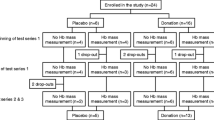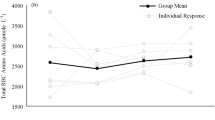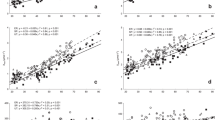Summary
A statistically significant 10% increase (ps<0.005) in mean red cell 2,3-diphosphoglycerate (2,3-DPG) concentration, concomitantly with a mean 16% increase (p<0.001) in the predicted maximal oxygen uptake (VO2 max) was observed in 29 recruits, who were studied during 6 months of physical training in military service. The increase in 2,3-DPG was higher, the lower the initial 2,3-DPG and VO2 max levels. The mean initial 2,3-DPG level was higher in the subjects with a higher initial VO2 max. A strenuous but highly aerobic 21-km marching exercise elicited a mean 9% increase (p<0.005) in red cell 2,3-DPG concentration. A significantly greater response of 2,3-DPG to marching exercise was observed in subjects with a lower pre-test VO2 max than in those with a higher pre-test VO2 max. During another more competitive march 2,3-DPG remained almost unchanged and was associated with a tendency towards a negative correlation with the accompanying lactate response (r=−0.60, p<0.05). Red cell 2,3-DPG response to a standardized exercise is considered to be a suitable indicator for evaluating the effect of training on an individual.
Similar content being viewed by others
References
Adamson, J. W., Finch, C. A.: Hemoglobin function, oxygen affinity, and erythropoietin. Ann. Rev. Physiol. 37, 351–369 (1975)
åstrand, P.-O., Rodahl, K.: Textbook of work physiology, pp. 613–627. New York: McGraw-Hill 1970
Astrup, P.: Red-cell pH and oxygen affinity of hemoglobin. N. Engl. J. Med. 283, 202–204 (1970)
Austin, R. L., Stegink, L. D., Gisolfi, C. V., Lauer, R. M.: The effect of exercise on red blood cell 2,3-diphosphoglycerate in children. J. Pediatr. 83, 41–45 (1973)
Benesch, R., Benesch, R. E.: Intracellular organic phosphates as regulators of oxygen release by haemoglobin. Nature 221, 618–622 (1969)
Beutler, E.: “A shift to the left” or “a shift to the right” in the regulation of erythropoiesis. Blood 33, 496–500 (1969)
Böning, D., Schweigart, U., Tibes, U., Hemmer, B.: Influences of exercise and endurance training on the oxygen dissociation curve of blood under in vivo and in vitro conditions. Eur. J. Appl. Physiol. 34, 1–10 (1975)
Danon, A., Sapira, J. D.: Uptake and metabolism of catecholamines by the human red blood cell. Clin. Pharmacol. Ther. 13, 916–922 (1972)
Dempsey, J. A., Rodriquez, J., Shahidi, N. T., Reddan, W. G., MacDougall, J. D.: Muscular exercise, 2,3-DPG and oxy-hemoglobin affinity. Int. Z. Angew. Physiol. 30, 34–39 (1971)
Eaton, J. W., Brewer, G. J.: The relationship between red cell 2,3-diphosphoglycerate and levels of hemoglobin in the human. Proc. Natl. Acad. Sci. USA 61, 756–760 (1968)
Eaton, J. W., Faulkner, J. A., Brewer, G. J.: Response of the human red cell to muscular activity. Proc. Soc. Exp. Biol. Med. 132, 886–887 (1969)
Ericson, å., de Verdier, C.-H.: A modified method for the determination of 2,3-diphosphoglycerate in erythrocytes. Scand. J. Clin. Lab. Invest. 29, 85–90 (1972)
Gerlach, E., Duhm, J.: 2,3-DPG metabolism of red cells: regulation and adaptive changes during hypoxia. In: Oxygen affinity of hemoglobin and red cell acid base status. RØrth, M., Astrup, P. (eds.), pp. 552–569. Copenhagen: Munksgaard 1972
Gorshein, D., Gardner, F. H., Tyree, W., Oski, F., Delivoria-Papadopoulos, M.: Effect of hyperoxia and androgen on red cell 2,3-diphosphoglycerate and oxygen affinity. Acta Haematol. 55, 306–312 (1976)
Hartley, L. H.: Growth hormone and catecholamine response to exercise in relation to physical training. Med. Sci. Sports 7, 34–36 (1975)
Hasart, E., Roth, W., Jagemann, K., Pansold, B.: 2,3-Diphosphoglyzeratkonzentration in Erythrozyten und körperliche Belastung. Med. Sport 13, 112–118 (1973)
Hasart, E., Roth, W., HÄrtel, R.: AffinitÄt des HÄmoglobins zum Sauerstoff unter dem Einflu\ körperlichen Trainings. Med. Sport 15, 349–352 (1975)
Hjelm, H.: The content of 2,3-diphosphoglycerate and some other phosphocompounds in human erythrocytes from healthy adults and subjects with different types of anaemia. Försvarsmedicin 5, 219–226 (1969)
HÄrkönen, M., Kormano, M.: Acute cadmium-induced changes in the energy metabolism of the rat testis. J. Reprod. Fertil. 21, 221–226 (1970)
Kunski, H., Sztobryn, M.: The effect of physical exercise on 2,3-diphosphoglyceride (2,3-DPG) concentration in erythrocytes. Acta Physiol. Pol. 27, 293–299 (1976)
Lichtman, M. A., Miller, D. R., Cohen, J., Waterhouse, C.: Reduced red cell glycolysis, 2,3-diphosphoglycerate and adenosine triphosphate concentration, and increased hemoglobin-oxygen affinity caused by hypophosphatemia. Ann. Intern. Med. 74, 562–568 (1971)
MacDonald, R.: Red cell 2,3-diphosphoglycerate and oxygen affinity. Anaesthesia 32, 544–553 (1977)
Molinari, P. F., Chung, S. K., Snyder, L. M.: Variations of erythrocyte glycolysis following androgens. J. Lab. Clin. Med. 81, 443–446 (1973)
Parker, J. P., Beirne, G. J., Desai, J. N., Raich, P. C., Shahidi, N. T.: Androgen-induced increase in redcell 2,3-diphosphoglycerate. N. Engl. J. Med. 287, 381–383 (1972)
Rand, P. W., Norton, J. M., Barker, N., Lovell, M.: Influence of athletic training on hemoglobin-oxygen affinity. Am. J. Physiol. 224, 1334–1337 (1973)
Rapoport, S.: Regulation of concentration of DPG and ATP in red blood cells. Försvarsmedicin 5, 168–172 (1969)
Remes, K., HÄrkönen, M., Vuopio, P., Peltokallio, P.: The decrease in red cell 2,3-diphosphoglycerate concentration in long-distance running. J. Sports Med. 15, 113–116 (1975)
Remes, K.: Effect of long-term physical training on total red cell volume. Scand. J. Clin. Lab. Invest. 39, 311–319 (1979)
Richterich, R.: Einführung in die Statistik. In: Klinische Chemie. Theorie und Praxis, S. 17–36. Basel: Karger 1968
RØrth, M.: Effect of hypoxia on erythrocyte metabolism and function. Ser. Haematol. 5, 65–78 (1972)
RØrth, M.: Hypoxia, red cell oxygen affinity and erythropoietin production. Clin. Haematol. 3, 595–607 (1974)
Shappell, S. D., Murray, J. A., Bellingham, A. J., Woodson, R. D., Detter, J. C., Lenfant, C.: Adaptation to exercise: role of hemoglobin affinity for oxygen and 2,3-diphosphoglycerate. J. Appl. Physiol. 30, 827–832 (1971)
Siegel, S.: Nonparametric statistics for the behavioral sciences, pp. 116–127. Tokyo: McGraw-Hill Kogakusha 1956
Taunton, J. E., Taunton, C. A., Banister, E. W.: Alterations in 2,3-dpg and p50 with maximal and submaximal exercise. Med. Sci. Sports 6, 238–241 (1974)
Thomson, J. M., Dempsey, J. A., Chosy, L. W., Shadidi, N. T., Reddan, W. G.: Oxygen transport and oxyhemoglobin dissociation during prolonged muscular work. J. Appl. Physiol. 37, 658–664 (1974)
Travis, S. F., Sugerman, H. J., Ruberg, R. L., Dudrick, S. J., Delivoria-Papadopoulos, M., Miller, L. M., Oski, F. A.: Alterations of red-cell glycolytic intermediates and oxygen transport as a consequence of hypophosphatemia in patients receiving intravenous hyperalimentation. N. Engl. J. Med. 285, 763–768 (1971)
Author information
Authors and Affiliations
Rights and permissions
About this article
Cite this article
Remes, K., Vuopio, P. & HÄrkönen, M. Effect of long-term training and acute physical exercise on red cell 2,3-diphosphoglycerate. Europ. J. Appl. Physiol. 42, 199–207 (1979). https://doi.org/10.1007/BF00431026
Accepted:
Issue Date:
DOI: https://doi.org/10.1007/BF00431026




